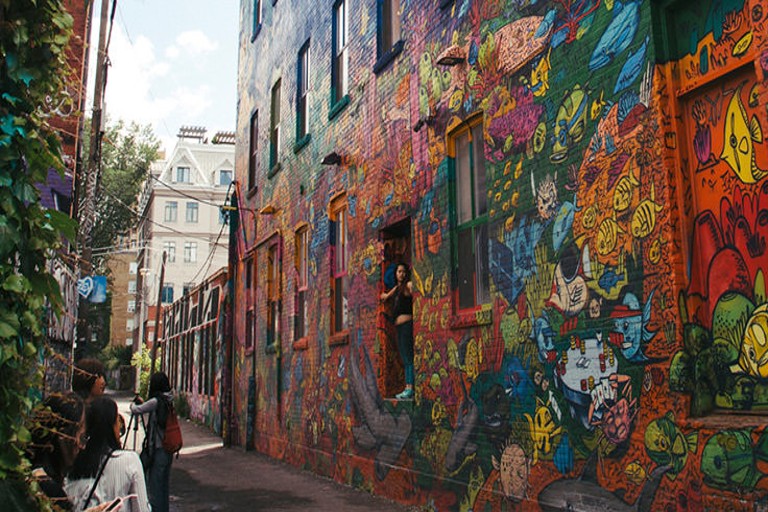In the heart of Toronto, colour spills across concrete walls, underpasses, and alleyways in a living gallery that stretches for miles. Once considered blank urban canvases, these walls now tell stories of resilience, diversity, and transformation. The city’s street mural movement has evolved from fringe expression to celebrated cultural identity, redefining how residents and visitors experience the metropolis.
Kensington Market, Queen West, and the laneways of the Junction have become some of Toronto’s most photographed outdoor art destinations. Each mural, from small tags to towering façades, contributes to a mosaic of voices that reflect the city’s creative spirit. What began as grassroots activism has matured into a recognized cultural phenomenon supported by artists, local businesses, and city officials alike.
For many artists, the streets provide a space for accessibility and dialogue. Unlike galleries that often cater to limited audiences, murals invite everyone to engage. Pedestrians become participants—pausing, photographing, and sharing the works that line their daily commutes. The democratization of art, advocates say, is what makes these murals so essential to the city’s evolving story.
One of the movement’s early champions, muralist Elicser Elliott, says that the goal has always been connection. “It’s about the energy between people and place,” he explains. “When you paint on a wall that thousands walk by every day, you’re adding to the city’s rhythm—you’re making memory visible.” Elliott’s murals, known for their dreamlike human figures, have become local landmarks in their own right.
The city’s StreetARToronto (StART) program has played a major role in transforming vandalized spaces into curated outdoor exhibitions. Through partnerships with community groups and private property owners, StART commissions artists to design murals that reflect local history and social diversity. Since its founding in 2012, the initiative has supported over a thousand projects across Toronto’s neighbourhoods.
One standout example is the 'Equilibrium' mural on Bloor Street, depicting a vivid panorama of faces symbolizing harmony amid difference. Commissioned through StART’s diversity initiative, the work was created by a team of emerging artists from across the GTA. For many, it represents the best of what public art can achieve: inclusion, collaboration, and inspiration drawn from real community voices.
Beyond beautification, murals are shaping urban renewal and safety efforts. City planners report that vibrant wall art helps deter vandalism and graffiti tagging while improving pedestrian engagement. Areas once perceived as unsafe now attract tourists and local shoppers. The economic ripple effect has led to new cafés, galleries, and markets springing up near major mural corridors.
Corporate partnerships, once hesitant to associate with street art, are now embracing the cultural value of murals. Major Canadian brands have begun sponsoring artists to create works that blend storytelling with subtle branding. While some critics warn of commercialization, others see this trend as an opportunity to give artists sustainable income and global exposure.
In recent years, digital technology has expanded the reach of Toronto’s murals far beyond their physical walls. Drone photography, augmented reality tours, and interactive maps now allow art enthusiasts to explore murals virtually. The integration of technology has turned street art into a shared online experience, connecting communities across Canada and abroad.
For local artists, the challenge remains balancing authenticity with visibility. “When a mural goes viral, it can lose its local roots,” says artist Peru Dyer Jalea, who has painted more than 40 public works in Toronto. “But if it sparks a conversation—about identity, justice, or joy—then it’s done its job.” His comment echoes the sentiment shared by many in the scene: art belongs to the people who live with it every day.
The city’s annual Mural Routes Festival has become a cornerstone event for artists and art lovers alike. It brings together painters, musicians, and storytellers to celebrate the transformative power of public art. Murals completed during the festival often carry themes of reconciliation, cultural pride, and urban ecology, marking each wall as both a creative statement and a civic gesture.
For Toronto residents, the murals have become part of the city’s emotional geography. Locals navigate by them, point them out to visitors, and watch eagerly as new works rise overnight. These creations, often ephemeral and subject to change, embody the dynamic rhythm of a city constantly reinventing itself.
What started as acts of expression by a handful of street artists has evolved into a defining feature of Toronto’s identity. The murals are no longer just decoration—they are dialogue, history, and heartbeat. Together, they remind Canada’s largest city that art, when painted on shared walls, belongs to everyone.
